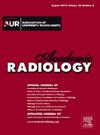Radiomics of Multimodal Ultrasound for Early Prediction of Pathologic Complete Response to Neoadjuvant Chemotherapy in Breast Cancer
IF 3.8
2区 医学
Q1 RADIOLOGY, NUCLEAR MEDICINE & MEDICAL IMAGING
引用次数: 0
Abstract
Rationale and Objectives
To construct and validate a clinical-radiomics model based on radiomics features extracted from two-stage multimodal ultrasound and clinicopathologic information for early predicting pathologic complete response (pCR) to neoadjuvant chemotherapy (NAC) in breast cancer patients treated with NAC.
Materials and Methods
Consecutive women with biopsy-proven breast cancer undergoing multimodal US pretreatment and after two cycles of NAC and followed by surgery between January 2014 and November 2023 were retrospectively collected for clinical-radiomics model construction (n = 274) and retrospective test (n = 134). The predictive performance of it was further tested in a subsequent prospective internal test set recruited between January 2024 to July 2024 (n = 76). Finally, a total of 484 patients were enrolled. The clinical-radiomics model predictive performance was compared with radiomics model, clinical model and radiologists’ visual assessment by area under the receiver operating characteristic curve (AUC) analysis and DeLong test.
Results
The proposed clinical-radiomics model obtained the AUC values of 0.92 (95%CI: 0.88, 0.94) and 0.85 (95%CI: 0.79, 0.89) in retrospective and prospective test sets, respectively, which were significantly higher than that those of the radiomics model (AUCs: 0.75–0.85), clinical model (AUCs: 0.68–0.72) and radiologists’ visual assessments (AUCs:0.59–0.68) (all p < 0.05). In addition, the predictive efficacy of the radiologists was improved under the assistance of the clinical-radiomics model significantly.
Conclusion
The clinical-radiomics model developed in this study, which integrated clinicopathologic information and two-stage multimodal ultrasound features, was able to early predict pCR to NAC in breast cancer patients with favorable predictive effectiveness.
多模态超声放射组学对乳腺癌新辅助化疗病理完全反应的早期预测。
目的:建立并验证基于两期多模态超声提取的放射组学特征和临床病理信息的临床-放射组学模型,用于早期预测乳腺癌患者对新辅助化疗(NAC)的病理完全缓解(pCR)。材料和方法:回顾性收集2014年1月至2023年11月期间连续接受多模式US预处理和两个周期NAC并随后手术的活检证实的乳腺癌妇女,进行临床放射组学模型构建(n = 274)和回顾性试验(n = 134)。在2024年1月至2024年7月期间招募的后续前瞻性内部测试集(n = 76)中,进一步测试了该方法的预测性能。最终,共有484名患者入组。通过受试者工作特征曲线下面积(AUC)分析和DeLong检验,比较临床-放射组学模型与放射组学模型、临床模型和放射科医师视觉评价的预测效果。结果:提出的临床-放射组学模型在回顾性和前瞻性测试集的AUC值分别为0.92 (95%CI: 0.88, 0.94)和0.85 (95%CI: 0.79, 0.89),显著高于放射组学模型(AUC: 0.75 ~ 0.85)、临床模型(AUC: 0.68 ~ 0.72)和放射科医师视觉评估(AUC:0.59 ~ 0.68)(均p)。本研究建立的临床-放射组学模型整合了临床病理信息和两期多模态超声特征,能够早期预测乳腺癌患者的pCR至NAC,预测效果良好。
本文章由计算机程序翻译,如有差异,请以英文原文为准。
求助全文
约1分钟内获得全文
求助全文
来源期刊

Academic Radiology
医学-核医学
CiteScore
7.60
自引率
10.40%
发文量
432
审稿时长
18 days
期刊介绍:
Academic Radiology publishes original reports of clinical and laboratory investigations in diagnostic imaging, the diagnostic use of radioactive isotopes, computed tomography, positron emission tomography, magnetic resonance imaging, ultrasound, digital subtraction angiography, image-guided interventions and related techniques. It also includes brief technical reports describing original observations, techniques, and instrumental developments; state-of-the-art reports on clinical issues, new technology and other topics of current medical importance; meta-analyses; scientific studies and opinions on radiologic education; and letters to the Editor.
 求助内容:
求助内容: 应助结果提醒方式:
应助结果提醒方式:


